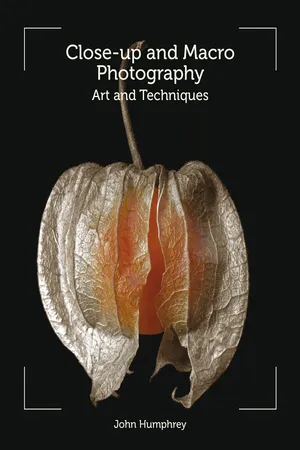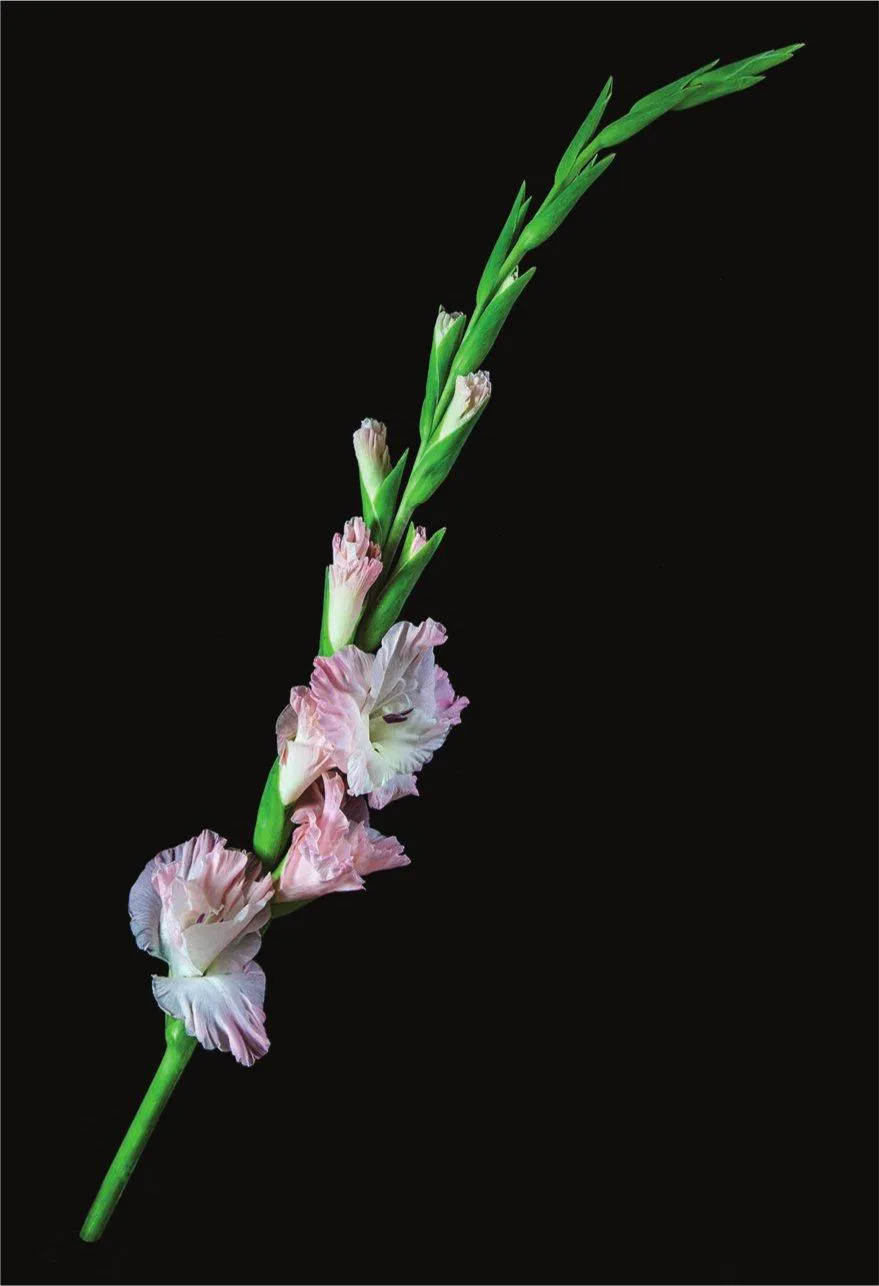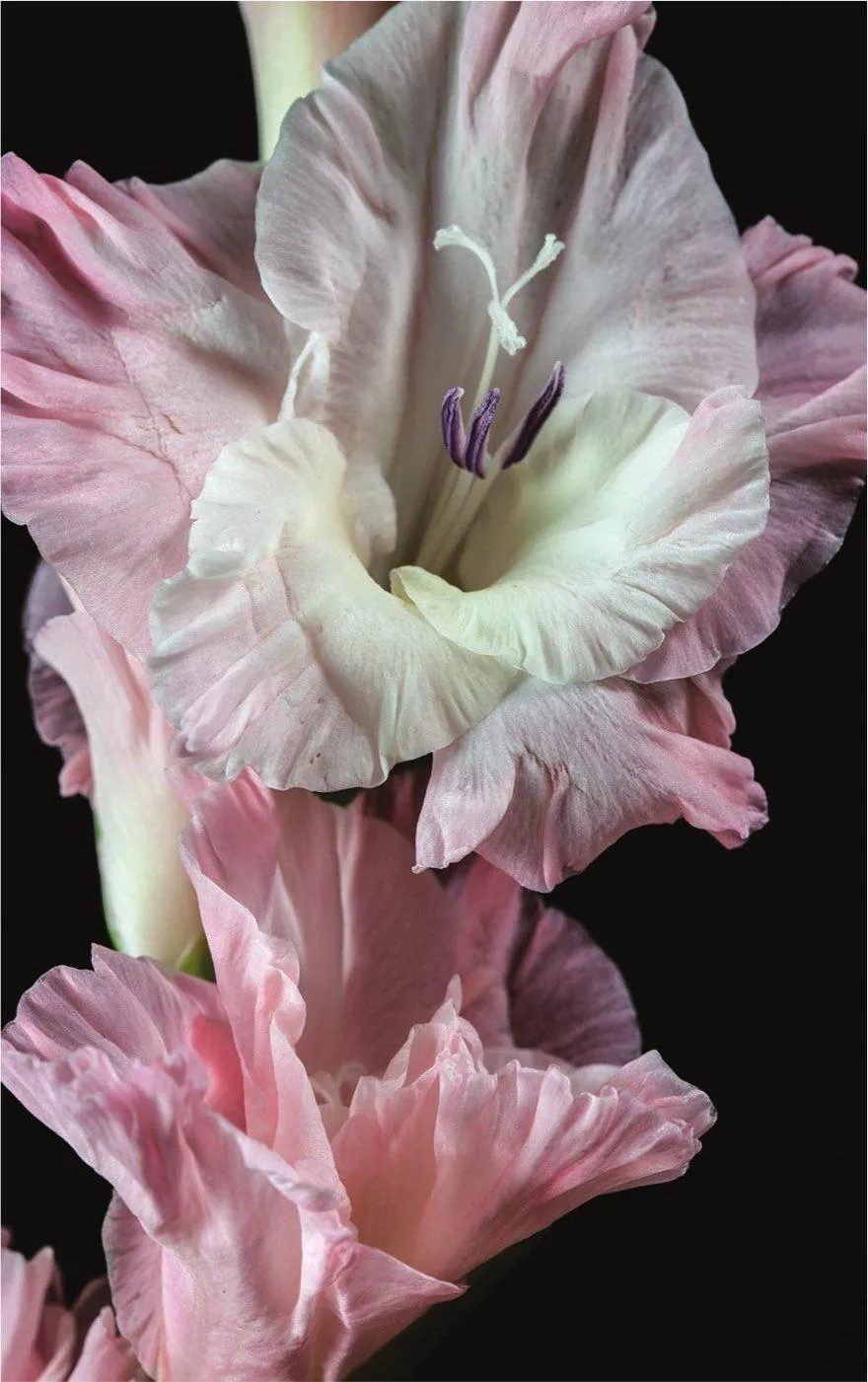
- 160 pages
- English
- ePUB (mobile friendly)
- Available on iOS & Android
eBook - ePub
About this book
High magnification photography is immensely exciting and rewarding. Through the close-up lens, everyday objects produce striking images, and small creatures show amazing detail that usually goes unnoticed. This book is both a practical guide to each step of the close-up process, as well as a source of inspirational ideas and subjects for producing high-impact images. Topics covered include: cameras, lenses and equipment; step-by-step techniques for high quality results; ideas for close-up subjects, including flowers, insects and still life; composing close-up pictures for maximum impact; using software for creative effect and suggestions for presenting macro photographs.Superbly illustrated with 229 stunning colour photographs.
Frequently asked questions
Yes, you can cancel anytime from the Subscription tab in your account settings on the Perlego website. Your subscription will stay active until the end of your current billing period. Learn how to cancel your subscription.
No, books cannot be downloaded as external files, such as PDFs, for use outside of Perlego. However, you can download books within the Perlego app for offline reading on mobile or tablet. Learn more here.
Perlego offers two plans: Essential and Complete
- Essential is ideal for learners and professionals who enjoy exploring a wide range of subjects. Access the Essential Library with 800,000+ trusted titles and best-sellers across business, personal growth, and the humanities. Includes unlimited reading time and Standard Read Aloud voice.
- Complete: Perfect for advanced learners and researchers needing full, unrestricted access. Unlock 1.4M+ books across hundreds of subjects, including academic and specialized titles. The Complete Plan also includes advanced features like Premium Read Aloud and Research Assistant.
We are an online textbook subscription service, where you can get access to an entire online library for less than the price of a single book per month. With over 1 million books across 1000+ topics, we’ve got you covered! Learn more here.
Look out for the read-aloud symbol on your next book to see if you can listen to it. The read-aloud tool reads text aloud for you, highlighting the text as it is being read. You can pause it, speed it up and slow it down. Learn more here.
Yes! You can use the Perlego app on both iOS or Android devices to read anytime, anywhere — even offline. Perfect for commutes or when you’re on the go.
Please note we cannot support devices running on iOS 13 and Android 7 or earlier. Learn more about using the app.
Please note we cannot support devices running on iOS 13 and Android 7 or earlier. Learn more about using the app.
Yes, you can access Close-Up and Macro Photography by John Humphrey in PDF and/or ePUB format, as well as other popular books in Art & Photography. We have over one million books available in our catalogue for you to explore.
Information
Chapter 1
The Basics
The world of close-up and macro photography is full of jargon and technical terminology, often used rather casually. This chapter sets out and defines the main terms used throughout the book, and considers some of the key challenges in preparing for close-up work.
Close-up
Close-up photography is a descriptive term, rather than a precise scientific measure. It is simply used to describe photography where the subject is ‘close’. As a result it is rather dependent on the size of the subject. Taking a close-up picture of a fly presents quite a different challenge from taking a close-up picture of a horse.
In this book, close-up photography will cover images where the subject is reproduced at around one-twentieth of life-size or greater on the camera’s image sensor.

Fig. 1.2
This picture of a gladiolus flower is about one-twentieth life-size on the 36mm camera sensor, the lower end of close-up photography covered in this book.
This picture of a gladiolus flower is about one-twentieth life-size on the 36mm camera sensor, the lower end of close-up photography covered in this book.
Macro
Macro photography can be more precisely defined. It means that the image on the sensor is at least as large as the subject being photographed. A different way to express this is that the image has 1 × magnification or greater.
The words macro and photography are sometimes rolled together to produce photomacrography or macrophotography, although strictly speaking photomacrography means the production of very large photographs. To confuse things further, macro has different meanings in other fields such as computer science and word processing. When the image becomes very much larger than the subject, the term micro comes into play. This is used for photography requiring the use of a microscope.
The scope of this book is from the lower end of close-up photography through to the upper reaches of macro photography that can be achieved with readily available camera and lens assemblies. This range is roughly one-twentieth to ten times life-size on the camera sensor. In practical terms, the book covers the photography of subjects ranging from about 50cm across, down to about a quarter of 1cm.

Fig. 1.3
This detail of the gladiolus is about a quarter life-size on the sensor, within the capability of most cameras without specialist macro capability.
This detail of the gladiolus is about a quarter life-size on the sensor, within the capability of most cameras without specialist macro capability.

Fig. 1.4
Here the gladiolus detail is life-size on the 36mm camera sensor, just within the definition of a macro image.
Here the gladiolus detail is life-size on the 36mm camera sensor, just within the definition of a macro image.

Fig. 1.5
This element of the gladiolus is magnified by ten times on the camera sensor, the upper end of macro work covered in the book.
This element of the gladiolus is magnified by ten times on the camera sensor, the upper end of macro work covered in the book.
Your Equipment Might Not Be Macro
The term macro is often used casually and incorrectly. For example, on the kit zoom lens that came with my camera, the word macro is printed on the barrel despite the fact that it will only produce an image at around a quarter life-size. The manufacturers say this is to indicate where to set the zoom to obtain the closest possible focus, but in practice it is misleading. Don’t assume you are taking macro photographs just because your equipment has the word on it.
Reproduction Ratio
As you can see, the relative sizes of the object being photographed and its image on the camera sensor are critical in this field of photography. These relative sizes are represented by the reproduction ratio – the ratio of the size of the image to the size of the object.
If a subject, perhaps an average-size flower, measures 36mm across and its image just fits onto a 36mm camera sensor, then the reproduction ratio is 1:1. Other ways of expressing this, all commonly used in the close-up field, are to say that the image is ‘life-size’ or that it has one times (or 1×) magnification. Suppose that the flower is larger, say 72mm across, and the image still just fits the sensor. This is a less challenging photograph to take because it can be taken further away from the flower. The image is still 36mm across, half the size of the object, so the reproduction ratio is 1:2, half life-size, not technically a macro photograph. Now suppose the flower is just 18mm across, half the size of the sensor. If it can still be photographed so the image just fits the sensor then it is twice life-size and the reproduction ratio is 2:1. It is now being reproduced at two times (2×) magnification, well into the macro range.
Magnification Ratio
In close-up photography, where the aim is to produce a larger than life image on the sensor, it is often more descriptive to use the term magnification ratio than reproduction ratio. However, the terms mean the same thing. As you will see from the definitions so far, the same result can be presented in a number of ways. For clarity, the table is a reminder of the terms and the different ways of expressing them, and sets out the range of close-up and macro work covered by this book.
Table 1
WAYS OF PRESENTING MAGNIFICATION
| reproduction ratio (or magnification ratio) | how close to life-size | magnification |
| 1:20 | one-twentieth | 1/20 |
| 1:10 | one-tenth | 1/10 |
| 1:1 | life-size | 1× |
| 2:1 | twice | 2× |
| 10:1 | ten times | 10× |
HOW TO FIND OUT WHET HER YOU ARE TAKING MACRO PHOTOGRAPHS
As already noted, it is not always possible to rely on the way in which equipment is promoted and packaged to know whether your photographs are ‘macro’. To find out, the best way is to photograph something and then see how the size of the object being photographed relates to the resulting image. An accurate way to do this is to use a ruler and follow th...
Table of contents
- Cover
- Title Page
- Copyright
- CONTENTS
- Introduction
- Chapter 1: The Basics
- Chapter 2: The Camera and Lenses
- Chapter 3: Close-up Accessories
- Chapter 4: Lighting
- Chapter 5: Equipment Set-up
- Chapter 6: Photographing Flowers
- Chapter 7: Natural History Subjects
- Chapter 8: Still Life and Everyday Objects
- Chapter 9: Composition
- Chapter 10: Image Processing Software
- Chapter 11: Presenting Your Images
- Index
